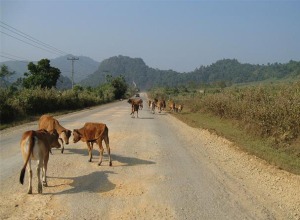I headed out onto the AH16, still part of the Asian network I have mentioned a few times, that cuts a line across this part of Laos towards Vietnam in the east. The Laos people seem to be pretty relaxed about everything. Every so often I get an intersection of roads where there are no traffic lights or policeman waving people this way and that. Instead, we all just weave around and get by. No bibbing of horns or road rage. I am noticeably over polite, and am always the most interesting sight on the road.
After the Geneva Conference in 1954, France eventually relinquished their hold over these countries and they became independent. To this aim, Vietnamese nationalists fought for a unified country under a Communist government, but the United States, along with the help of south Vietnamese, wanted to stop Communism wherever they found it, almost by any means. By the mid 60′s, the Vietnam war reached a new level, despite the US Government losing all support from the American public. Laos used a number of political agreements to try to stay out of the war, but after a major invasion on the Plain of Jars, it was inevitable that Laos was now part of the conflict. The US used most airfields to mount attacks on the neighbouring country. Massive aerial bombardment was carried out by the United States. The UK newspaper, The Guardian reported that Laos was hit by an average of one B-52 bombload every eight minutes, 24 hours a day, between 1964 and 1973.
 |
 |
I stop off at Phin to fill the tank and pick up some food. (Here’s a thought. Not all Petrol stations have all of the fuel types you might need. For instance, some only have leaded petrol, so many modern vehicles, which require unleaded fuel, may well have a problem. My habit of topping up when I can seems to be the best approach.) There are plenty of reminders of the war on this route, and I go and see the monument-like remains of the American helicopter in Muang Phin. As I carry on I head up into the Annamite mountain range that forms the border between Laos and Vietnam, I travel through a long valley and beside a river and it’s not long before I get to the Dansavan/Lao Bao border crossing. There’s a bit of a queue, and as far as I can find out the border is only open between 08:00 and 17:00. It’s only a little after two, so I should have plenty of time. I am heading to Dong Hoi, which is another two and a half hours drive. Again, I get a Visa on Arrival (VOA) into Vietnam, which costs between US$30 and US$40, depending on your natioanlity. This I find interesting, but can’t find the reason for different costs.
It takes about an hour and I pass through as part of a small convoy of similar-sized vehicles, through the Laos border arch, along the short road and through the Vietnam arch. Lao Bao, on the other side is much smaller than I thought it would be, but I have no time to stop and take a look.


